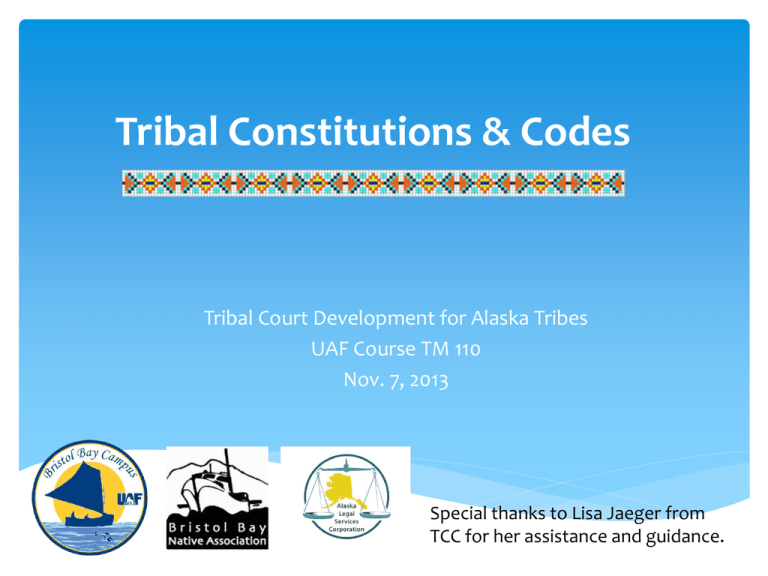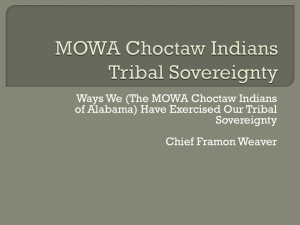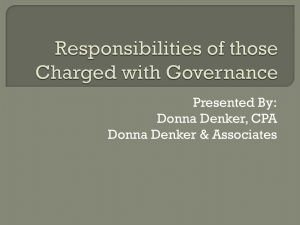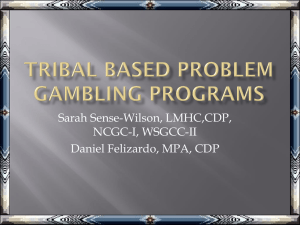
Tribal Constitutions & Codes
Tribal Court Development for Alaska Tribes
UAF Course TM 110
Nov. 7, 2013
Special thanks to Lisa Jaeger from
TCC for her assistance and guidance.
Power of the Tribe
Tribal Members
Constitution
Council
Tribal Court
Tribal Constitutions
What does your constitution provide for?
Why is the constitution important?
Why is it important to refer to your constitution?
In re J.M.
718 P.2d 150 (Alaska 1986)
Kaltag took custody of newborn boy.
Council President asked OCS to do whatever it needed to do to
provide foster care payments to the foster parents.
OCS filed a petition to take emergency custody of the baby.
Tribe filed motion to dismiss case because the Tribe already had
jurisdiction over the child.
State court decision was vacated because state did not have
jurisdiction over child.
Tribal Court Codes
“Written laws are like tracks in the snow.
They are evidence of tribal activity”
Will Mayo
Past President of Tanana Chiefs Conference
Terminology
Ordinance
- Code
- Statute
- Act
Codification
Function of Tribal Codes
Provide details for tribal government structures and procedures (I.e.
tribal court structure, election procedures)
Outline the laws that the tribal government will enforce
(I.e. curfew and vandalism of tribal property)
Regulate activities in the village
(I.e. the taking of artifacts and environmental regulation)
Provide for a smooth flow of government and continuity between
administrations
Promote respect from other governments and institutions
Protect Native cultural activities and traditions
Overview of Tribal Codes
Two basic kinds of ordinances:
Those that set up structures and procedures for the tribal government
enforced by tribal councils and by political pressure from tribal
members
Those that regulate activities and behaviors, enforced by tribal councils
and courts
Possible Tribal Codes
Title 1: Tribal Government Structures and Procedures
Title 2: Law and Order
Title 3: Domestic Relations
Title 4: Health and Safety
Title 5: Land Management
Title 6: Natural and Cultural Resources
Title 7: Tribal Business Operations
Law & Order Codes
Types of Codes:
Underage drinking
Trespass
Vandalism
Theft
Minor assaults
Truancy
Juvenile curfew
Disorderly conduct
Animal control
Traffic - speeding and such
Regulating firearm use in the village
Alcohol regulation
Health & Safety Codes
Types of Codes:
•
•
•
•
•
•
•
•
•
•
•
•
Animal Control
Abandoned Vehicles
Nuisances
Fireworks
Environmental regulation
Solid waste
Littering
Burn barrels
Hazardous waste
Hazardous materials
Outhouses and human waste
Water quality
Land Management Codes
Types of codes:
Council powers over land issues
Rights of tribal members and land use
Acquisition of land procedures
Managing tribally owned lands
Tribal land assignments
Land use planning policies and procedures
Domestic Relations
Types of Codes:
Child custody disputes and formalizing agreements
Child protection
Terminating parental rights
Foster home licensing
Adoptions
Guardianships
Marriage
Divorce/annulment
Probate
Elder Protection
Domestic Violence
Sample Tribal Court Codes: Court Structure
Kenaitze Tribal Court
Section 6: Court Structure
The Tribal Court will consist of a panel of judges. The Judges
shall be appointed by a majority vote of the Tribal Council. At
least two and no more than five judges will hear each case.
It shall be a preference that at least one elder judge presides
over every case that comes before the Tribal Court.
Sample Tribal Court Codes: Court Structure
Native Village of Barrow
Native Village of Barrow
Sample Tribal Court Codes: Court Structure
Native Village of Chignik Lagoon
Section 4(A) Court Structure:
The Chignik Lagoon Tribal Court shall be composed of 7
Judges, who shall be the 5 Tribal Council members and
two alternate Council members. The term of service
for a Tribal Court Judges shall coincide with their term
as a Council member or alternate member.
Sample Tribal Court Codes: Court Structure
Sitka Tribe of Alaska
Section 1.2 Judiciary.
The Court shall consist of one Chief Judge and such associate
judges as are appointed by the Tribal Council. To be eligible
to serve as a judge, a person must be over the age of 25 and
within the preceding five years not have been convicted of an
offense involving dishonesty or impugning his/her moral
character.
The judge shall hold office for a period of four years.
Sample Tribal Court Codes:
Termination
Sitka Tribe of Alaska
Native Village of Barrow
Curyung
Disclaimer and Credits
This project was supported by Grant No. 2012-AL-BX-K001
awarded by the Bureau of Justice Assistance. The Bureau of
Justice Assistance is a component of the Office of Justice
Programs, which also includes the Bureau of Justice Statistics,
the National Institute of Justice, the Office of Juvenile Justice
and Delinquency Prevention, the Office for Victims of Crime, the
Community Capacity Development Office, and the Office of Sex
Offender Sentencing, Monitoring, Apprehending, Registering,
and Tracking. Points of view or opinions in this document are
those of the author and do not necessarily represent the official
position or policies of the U.S. Department of Justice










